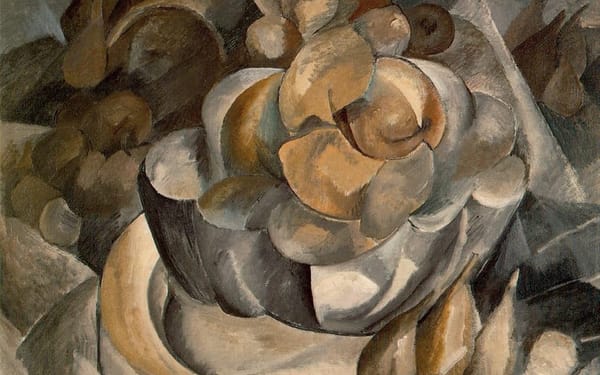True fictions
The storytelling instinct conjures illusions of consensus in science

Once upon a time, the universe blew up.
I say "blew up" not in the sense of an explosion, but rather click-and-dragging the corner of an image outwards to make it bigger. Right after the Big Bang, the universe was a tiny, compact mote. Practically everything that would eventually be anything was bound up not in familiar matter, but in the energy of exotic fields. But it didn't stay that way for long. In a split of a spilt of a split second — a splinter of time so small that more copies of it fit into a second than seconds fit into all time — the universe stretched out so quickly that even light couldn't keep up. By the end, it had grown by a factor of 1030. That's 1,000,000,000,000,000,000,000,000,000,000.
13.8 billion years later, this brief episode of cosmic inflation is still etched into the sky. Were it not for inflation, the universe would be roughly the same everywhere. And like a ball on an infinite, flat plain, it'd have nowhere to "go," no way to do anything other than sit still, forever. But some regions of space are a little denser or a little emptier than others. And when we train radio telescopes on the sky, we see a cosmic quilt of slightly brighter and slightly dimmer patches — tiny fluctuations in the radio afterglow of the Big Bang. Inflation explains the patchwork: quantum fluctuations near the beginning of time that started out tiny got blown up, click-and-drag style, to cosmic scale. Everything else, from stars to intelligences capable of doing cosmology, grew up over the primordial scaffold of disorder created by inflation.
Or did it?
Yesterday on a cycle across town, I played back an old episode of Sean Carroll's Mindscape podcast in which he interviewed Roger Penrose. I mostly associate Penrose with aperiodic tilings, but he's also a Nobel Prize-winning physicist with plenty of thoughts on cosmology. Carroll, a cosmologist, took the interview as a chance to discuss Penrose's ideas about the beginning and end of the universe.
I'd learned cosmic inflation as the story of the Big Bang — a solid scientific truth confirmed by observations of the cosmic microwave background. So you can imagine my shock at hearing Carroll and Penrose talk pretty dismissively about inflationary cosmology. Carroll said he'd place a 50/50 bet on inflation being true. Penrose doesn't buy it at all.
Penrose's alternative to inflation is called concentric cyclic cosmology or CCC, and attempts to verify its main prediction keep failing. But Penrose isn't the only one with problems with inflation. In 2017, physicists Anna Ijjas, Paul Steinhardt,[1] and Avi Loeb (yes, that Avi Loeb, but this was several months before his alien hunter metamorphosis) published an article in Scientific American criticizing inflationary cosmology. Their piece earned a response from 33 physicists, including Carroll. He described his position in a blog post as follows:
Now, as early-universe cosmologists go, I am probably less inclined to think that inflation is part of the final answer than most are. Many of my colleagues are more or less convinced that it’s correct, and it’s just a matter of nailing down parameters. I am much more concerned about the fine-tuning difficulties that make inflation hard to get started in the first place — in particular, the hilariously low entropy that is required. Nevertheless, inflation has so many attractive features that I still give it a fairly high Bayesian credence for being correct, above 50% at least.
I don't know about you, but that does not sound like how a scientist talks about consensus to me. Geologists certainly do not talk about plate tectonics — the field's grand unifying idea — as something they're more or less "inclined to think" is true, or which they'd give "fairly high" credence to. They take it as the truth.
Fact is, inflation is not the fact I thought it was. It is a widely accepted, well-supported theory. But there are competing ideas, including multiple flavors of a universe that periodically expands, contracts, and expands again in a "Big Bounce" rather than kicking off with a one-off bang. One of those flavors came from a trio of particle physicists who, until publishing their "Born Again Universe" paper in 2017, had nothing to do with the usual bounce cosmology gang. If you think that questioning inflation was just a late 2010s flare-up, think again. Physicists still get snagged on some of the theory's thornier aspects.
Why didn't I know any of this? You can blame my own ignorance — I certainly could have found out, and I didn't. But how fair is that? I'm not exactly a typical science-curious layperson. I'm a science journalist and have written multiple stories that touch on cosmology; none of the scientists I interviewed for those stories ever gave me the impression that inflation was anything but the accepted truth. Sites from institutions like ESA and the Harvard Center for Astrophysics present inflation as the story of the early universe, not the best working theory. We often find only what we seek, and I only found the debate around inflation after Carroll's podcast tipped me off that there was something to find.
What conjured the mirage of consensus?
Illusory agreement is a persistent feature of another field that I know much better than cosmology: the origins of life.
Grab someone off the street and ask them how life began, and you'd probably get a response like "get your hands off me, you weirdo." More seriously, the most popular story is some variation on "God did it." Nearly 40% of Americans think God created humans in their present form within the last 10,000 years, while only a quarter believe humans evolved without God's help (the rest can stomach evolution, but only with God pulling the strings).
Evolution, of course, only gets you so far. Before life can evolve, it needs to begin. Assuming you pressed the evolution crowd for their take on abiogenesis, I suspect they'd mostly agree on some flavor of primordial soup.
The primordial soup is a hypothetical broth of organic molecules like amino acids and sugars that, somehow, reacts to produce something like life. This idea is old, going at least back to the 19th century with Darwin's speculation that the first life might have emerged in some "warm little pond." Setting aside panspermia, which just exports the problem of life's origins to another world, the soup hypothesis was basically the only game in town until alternatives started bubbling up in the late 1990s — most notably Michael Russell's hypothesis that life began at a particular kind of seafloor hydrothermal vent. In research, soupism tends to overlap with a focus on organic chemistry and "information-first" hypotheses concerned with self-replicating molecules (usually RNA) and the beginning of Darwinian evolution. Conversely, ventism tends to overlap with "metabolism-first" thinking and focuses on the geochemical details of life's primordial cradle, as well as on self-catalyzing networks of reactions between simple molecules.
The soup has reigned supreme since at least 1952, when the famous Miller-Urey experiment produced simple organic molecules in an electrified organic "soup." The New York Times ran a story on the experiments, bringing the soup into public view:
[Miller] actually synthesized some amino acids and thus made chemical history by taking the first step that may lead a century or so hence to the creation of something chemically like beefsteak or white of egg. Miller is elated, and so is Professor Urey, his mentor... It is not an impossibility that a few generations hence synthetic muscle will be created, which will not be alive but which can be stretched just as we stretch our living muscles, which will spring back when released and which will even twitch when it is poked.
A few years later, NASA established its exobiology program and started funding quite a lot of soupy research. When Carl Sagan told life's origin story on Cosmos in the 1980, he started with primordial soup. Star Trek even picked up on the soup; in the the finale of Star Trek: The Next Generation, the godlike alien Q takes Captain Picard back in time to taunt him by playing with a handful of the "goo" humans evolved from. It ran in 1994.
Want to keep tabs on origin of life research? Become a patron to follow the custom RSS feed I've made to track new research on origins. There are also feeds for astrobiology and exoplanets — and plenty more are planned.
More nuance came into the popular picture around 2016, thanks to new discoveries about the last universal common ancestor of life on Earth, or LUCA. LUCA's reconstructed genome suggests that it probably lived somewhere very hot and had the metabolism you'd expect from a vent microbe. This TED-Ed video by marine biologist Luka (hah) Seamus Wright takes that evidence to espouse ventism. Kevin Mitchell's 2023 book on the evolution of free will presents a purely ventist origin at hydrothermal vents without even a drop of soup. This 2018 video from Be Smart starts with the soup, but ends up arguing for vents with a nod to LUCA — though they still don't drop the "soup" term for the water around vent. The soup is just too tasty!
Once you're attuned to the different language used by scientists in the information-first and metabolism-first camps, you start to feel like soup is lurking around every corner of popular discussion on the origins of life. This video from Crash Course mentions vents as one possible location where "life's soup can brew," but goes on to present a pretty soupy perspective focused on the formation of organic molecules and DNA through things like wet-dry and hot-cold cycles. The origin of life episode in Neil deGrasse Tyson's 2014 Cosmos reboot gets into a few possibilities, but they're all ultimately pretty soupy, organic chemistry-focused stories of life's origins. Soupist thinking even creeps into astrobiology; the focus on searching for organic "building blocks of life" on other worlds is a habit I'd argue reflects the soupy idea that getting life going is just a matter of bringing the right molecules into close proximity.
This is all to say that it'd be quite easy to end up rather convinced that scientists had more-or-less figured out the origin of life: it happened in a primordial soup. Or if it didn't start there, then it certainly started at a vent.
Except that's not true at all. While the RNA world is probably the most popular hypothesis for the origin of life right now, the field is more diverse than it's ever been. I don't think any serious scientist working on origins would tell you there's anything like a consensus. Another mirage.
Transporting information from one human head into another often requires coercing it into a particular shape.
Free-range facts unconstrained by story carry only their own atomic meaning. The Sun's corona is 2 million degrees Fahrenheit. The first recorded performance of Shakespeare's The Taming of the Shrew was at Newington Butts Theatre. Magma is subsurface molten rock. Great. So what? Just as 1000 starlings can be a bunch of birds or a mesmerizing murmuration depending on their context, scattered statements become something more when meshed together in just the right network of interrelationships. The network that seems to sit most easily in our minds is a story: a sequence of statements strung together by cause and effect. A caused B, the end. A chain of random statements is not a story. Each element needs to somehow trigger the following element. "The sun rises, it is day, the end" is a story. "The sun rises, my sock has a hole in it, the end" is not a story.
Try writing a nonsense series of facts and you'll see just how hard it is to avoid logical links between ideas. Here was my first attempt at writing the list of three nonsense facts from preceding paragraph:
The Sun is 150 million kilometers from Earth. Shakespeare wrote A Midsummer Night's Dream in 1595 or 1596. The German word for sky is Himmel.
Numbers, language, and even — embarrassingly — the heavens hold the chain together. I can easily concoct a story explaining the whole thing: I thought of the fact about the Sun because I had lunch with a heliophysicist friend today. Sun and Shakespeare both start with S (I'm alliteration affine), and A Midsummer Night's Dream alludes to night, an echo of the Sun in the previous fact. This needs to sound random, so let's do a date instead of distance. Thinking of Shakespeare reminds me of literature and language, and I've been reading a lot of German literature lately. What do the Sun and the night have in common? The sky (another S). Himmel.
There are researchers who study our species' narrative addiction, but my own pet theory is that we crave stories because fixating on cause and effect (A caused B, the end) is a good evolutionary strategy. A theoretical organism that craved fact networks of the structure "A is a thing, B is a thing, the end" would not tame fire. It probably wouldn't even survive very long. Organisms learn cause-and-effect to act on the world. With science, we humans have elevated that messy (and often deadly) process to, well, a science. But we can go even further. We routinely concoct entirely fake stories to spare ourselves the trouble of learning cause-and-effect the hard way: cry "wolf" too many times, and nobody will believe you.
Whatever the origin of our fiction fixation, it is almost impossible to imagine how human thought would work without the scaffolding of story. Even mathematics is no escape — what is a proof but a story about the journey from ignorance to insight? The storytelling drive is so strong that we readily concoct narratives out of whole cloth to fill gaps in our memories and intuitively prefer just about any explanation, no matter how infeasible, to random chance.
I think this goes a long way to explaining consensus mirages in science.
Stories almost never as simple as "A caused B, the end." The possible embellishments are endless. But the arrow from A to B is the backbone. It holds up everything else. And I'd wager that the further a story element strays from that spine, the less likely it is to stick in an audience or reader's mind. You probably remember that Luke Skywalker rescues Princess Leia from the Death Star, but only nerds know the name of Leia's home planet.
Telling a good story about anything, science or not, means deciding what's on the spine and what's relegated to the limbs. The origin of life at hydrothermal vents and the origin of life in warm little pond are two different stories. Perhaps they could be two equally meaty arms attached to a story spine about the broader quest to understand life's origins. But that's not the same thing as the story of life itself. If you're trying to tell that tale, you can't have two tailbones — one origin story will end up on the spine and the other, if it survives at all, will end up somewhere on the periphery where it is less likely to be remembered.
If this is true, it means some funny things for science communication. Story demands that we construct a line from A to B. And that means that even a perfectly accurate story, one that fully acknowledges that the particular tale it's telling is just one of many, isn't enough to keep nuance from getting lost. Even if we're shown the full animal, most of us will only see the skeleton, the stick-figure version. Who knows, maybe I even read a cautious story about inflation somewhere that took time to share a little nuance. If I did, I certainly don't remember it.
I'm not sure if there's a way out of this. When I imagine science writing without storytelling, I imagine nothing. As much as fact-collector types[2] bristle at the thought of degrading their data by dressing it up in a story, it simply must be done. Editors often have to tell writers, especially new ones, to stop pitching topics and come back with a story: "someone doing something for a reason." Story is the best way to reach people. But stories about big, open questions in science seem almost doomed to oversimplification.
The frontier of science — especially in speculative fields like astrobiology and cosmology — is a beach, not a cliff. There's no fine line between the known and unknown. Are you in the ocean once you're standing on wet sand? Does it only count once you're up to your ankles in the surf? Up to your knees? And when is the real shoreline revealed: high tide or low?
Someone who actually walks along the beach, of course, knows that it's all rather complicated. The true boundary between sand and sea is undefined, and maybe the whole idea of a shoreline will be thrown out and replaced with something else someday. But if you want to draw a map of the beach for someone else, you'll need to draw a line somewhere — preferably somewhere reasonable. Even if it's a fiction, it should at least be a true one.
Footnotes
[1]: You might know Paul Steinhardt better for his work on quasicrystals. I recently interviewed him for New Scientist about his ongoing hunt for natural quasicrystals; I had no idea when I met with him on Zoom that he was also a critic of inflationary cosmology! The science world feels smaller and smaller the longer I do this.
[2]: At least some of the divide between experimentalists and theorists, I think, comes down to how happy one is to simply collect information without telling stories about it.
Thanks for reading
There are many ways you can help:
- Subscribe, if you haven't already!
- Share this post on Bluesky, Twitter/X, LinkedIn, Facebook, or wherever else you hang out online.
- Become a patron for the price of 1 cappuccino per month
- Drop a few bucks in my tip jar
- Send recommendations for research to feature in my monthly paper roundups to elise@reviewertoo.com with the subject line "Paper Roundup Recommendation"
- Tell me about your research for a Q&A post (email enquiries to elise@reviewertoo.com)
- Follow me on Bluesky
- Spread the word!




